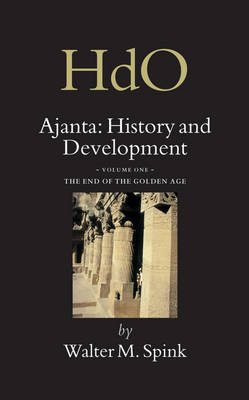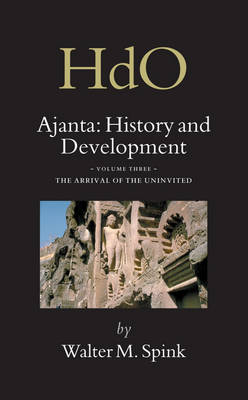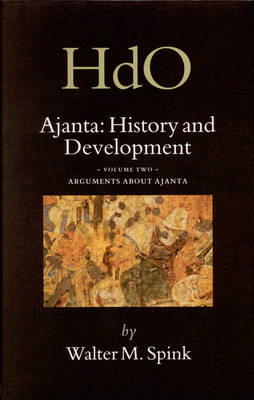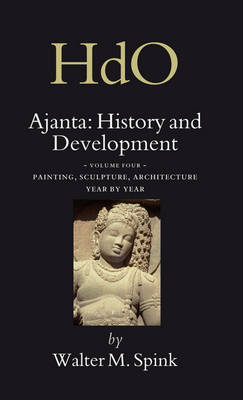Handbook of Oriental Studies. Section 2 South Asia / Ajanta: History and Development
7 total works
18/1
Ajanta: History and Development, Volume 1 The End of the Golden Age
by Walter Spink
Published 28 October 2005
The twenty-nine Buddhist caves near Ajanta form a devotional complex which ranks as one of the world's most startling achievements, created at the very apogee of India's Golden Age.
Ajanta: History and Development, appears as part of the series Handbook of Oriental Studies, present the reader with a systematic treatment of all aspects of the site, the result of forty years of painstaking research in situ by Walter M. Spink.
Volume one deals with the historical context in which this dramatic burst of pious activity took place under the reign of Vakataka emperor Harisena, (c. 460 - 477 A.D.), and with the sudden halt of activity almost immediately following the death of the emperor. In surprising detail the relative and absolute chronology of the site can be established from a careful reading of the physical evidence, with consequences for our dating of India's Golden Age. Ajanta, it appears, is a veritable illustrated history of Harisena's times, crowded with information on its history, development and how it was used.
Originally published in hardcover
Ajanta: History and Development, appears as part of the series Handbook of Oriental Studies, present the reader with a systematic treatment of all aspects of the site, the result of forty years of painstaking research in situ by Walter M. Spink.
Volume one deals with the historical context in which this dramatic burst of pious activity took place under the reign of Vakataka emperor Harisena, (c. 460 - 477 A.D.), and with the sudden halt of activity almost immediately following the death of the emperor. In surprising detail the relative and absolute chronology of the site can be established from a careful reading of the physical evidence, with consequences for our dating of India's Golden Age. Ajanta, it appears, is a veritable illustrated history of Harisena's times, crowded with information on its history, development and how it was used.
Originally published in hardcover
18/3
Ajanta: History and Development, Volume 3 The Arrival of the Uninvited
by Walter Spink
Published 28 October 2005
Volume Three in the Ajanta series focuses on what the site tells us about what happened in the months following the death of emperor Harisena (478 A.D.).
In that year the great "Vakataka" patrons had to flee from Ajanta as a result of the Asmakas' takeover of the site. When soon the Asmakas themselves also had to leave because of the needs of war, the great phase of patronage ended at Ajanta. But now a host of pious intruders, mostly monks and devotees still living in the region, could make their own offerings, generally violating the original patrons' programs. In this systematic cave to cave treatment, it is shown through careful interpretation of the physical evidence, that remarkably these new and "uninvited" paintings and sculptures appear only on and/or in caves which had already been dedicated by the earlier patrons. By contrast, excavations where the Buddha image had not been completed, were never utilized for such votive donations.
In that year the great "Vakataka" patrons had to flee from Ajanta as a result of the Asmakas' takeover of the site. When soon the Asmakas themselves also had to leave because of the needs of war, the great phase of patronage ended at Ajanta. But now a host of pious intruders, mostly monks and devotees still living in the region, could make their own offerings, generally violating the original patrons' programs. In this systematic cave to cave treatment, it is shown through careful interpretation of the physical evidence, that remarkably these new and "uninvited" paintings and sculptures appear only on and/or in caves which had already been dedicated by the earlier patrons. By contrast, excavations where the Buddha image had not been completed, were never utilized for such votive donations.
18/2
Ajanta: History and Development, Volume 2 Arguments about Ajanta
by Walter Spink
Published 1 January 2006
Volume Two begins with writings by some of the most important critics of Walter Spink's conclusions, interspersed with his own responses, using a thorough analysis of the great Cave 26 to support his assertions. The author then turns to matters of patronage, and to the surprising fact that, unlike most other Buddhist sites, Ajanta was purely "elitist", developed by less than a dozen major patrons. Its brief heyday traumatically ended, however, with the death of the great emperor Harisena in about 477, creating political chaos. Ajanta's anxious patrons now joined in a headlong rush to get their shrines dedicated, in order to obtain the expected merit, before they fled the region, abandoning their caves to the monks and local devotees remaining at the now-doomed site. These "intrusive" new patrons now filled the caves with their own helter-skelter votive offerings, paying no heed to the well-laid plans of the years before. A similar pattern of patronage is to be found in the redecoration of the earlier Hinayana caves, where the careful planning of the work being done during Harisena's reign is suddenly interrupted by a host of individual votive donations. The volume ends with a new and useful editing of Ajanta inscriptions by Richard S. Cohen.
18/4
Ajanta: History and Development, Volume 4 Painting, Sculpture, Architecture - Year by Year
by Walter Spink
Published 1 June 2008
Ajanta:Year by Year is planned as a biography of this remarkable site, starting with the earliest caves, dating from some two thousand years, to its startling renaissance in the brief period between approximately 462 and 480. Concentrating on the excavations of the later period, during the reign of the Vakataka emperor Harisena, it attempts to show how, after a surprising gap of some three hundred years, Ajanta's proud and pious courtly patrons and its increasingly committed workmen created not only the greatest but the latest monument of India's Golden Age. Nearly three hundred illustrations, in color and black and white, reveal the exuberant flowering of Ajanta and related Vakataka monuments, as well as the manner of their sudden demise.
18/5
Volume Five comprises, along with introductory comments, two "cave by cave" guides. One which, very briefly, describes the character of each cave and its patronage, is intended to be useful for the general visitor to the site. The other, very detailed, discusses the position and peculiarities of each cave in relation to the overall, year by year, development of the site. This volume also contains a complete set of cave plans, and various illuminating charts, graphs, outlines, and maps.
18/7
Ajanta: History and Development, Volume 7 Bagh, Dandin, Cells and Cell Doorways
by Walter Spink
Published 9 January 2017
Volume 7 of Walter Spink's monumental and still controversial study of the famous Ajanta caves considers the many connections between the Bagh caves and its "sister site", Ajanta, particularly emphasizing the leading role that Bagh plays in the crucial matter of Buddhist shrine development and the transition from the aniconic to iconic forms of worship. He also explains the relationships between certain caves and solstices, as well as changing technologies, especially in the development of the door fittings in the monks' cells.
18/6
Ajanta: History and Development, Volume 6 Defining Features
by Walter Spink
Published 1 January 2014
Volume 6, in Walter Spink's detailed analysis of the creation and development of the Ajanta caves, during the reign of the emperor Harisena (c.460-c.477) has had a profound and often upsetting impact on the understanding of Indian history in the so-called Golden Age. The author contends that through the discipline of Art History one can in fact change the established view of cultural developments in the crucial "Classic Age" (5th Century CE). One of his major aims is to prove that it was the Vakatakas, under the emperor Harisena, and not the Guptas, that brought Indian culture to its apogee in the late 470s and to show that by analyzing and organizing Ajanta's "defining feature" in revealing developmental sequences, one can support, with specifics, the revolutionary (but now increasingly accepted) "short chronology" for which the author is well known. These "defining features" range from the changing types of Buddha images and living arrangements for the monks, to the precise analysis of the evolution of pillars, doorways, and excavation techniques. The volume also includes, at the start, a discussion of the transforming effect of competition, and finally war, as a key to Ajanta's highly driven development, its florescence, and finally its sad demise.






